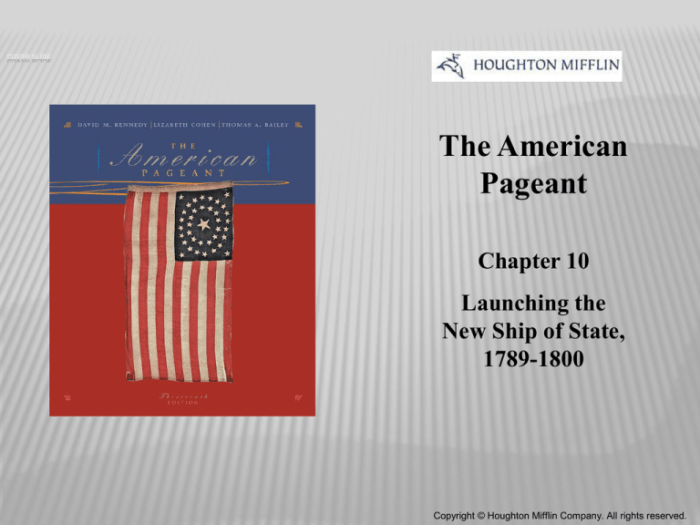Embarking on an exploration of American Pageant Chapter 12 Notes, this discourse delves into the intricacies of the Gilded Age and its profound impact on American society, politics, and culture. Through an in-depth examination of economic transformations, urbanization, immigration, and foreign policy, we uncover the complexities of this pivotal era.
As we navigate the chapter’s key themes and concepts, we will unravel the rise of big business, the challenges faced by urban populations, the motivations and consequences of large-scale immigration, and the emergence of political and social reform movements. Furthermore, we will explore the cultural and artistic trends that shaped the Gilded Age, examining the influence of industrialization and urbanization on American art and literature.
Chapter Overview: American Pageant Chapter 12 Notes
Chapter 12 of the American Pageant textbook examines the Gilded Age, a period of rapid economic and social change in the United States. The chapter explores the rise of big business, the growth of cities, the challenges faced by urban populations, and the emergence of political and social reform movements.
It also discusses the United States’ expansionist policies and the consequences of American imperialism.
The Gilded Age and Industrialization
The Gilded Age was a period of rapid economic growth and industrialization in the United States. The rise of big business, such as Standard Oil and Carnegie Steel, led to the concentration of wealth in the hands of a few individuals.
Industrialization transformed American society, creating new jobs and opportunities but also leading to the exploitation of workers and the growth of slums in cities.| Characteristic | Wealthy | Poor ||—|—|—|| Housing | Mansions, large apartments | Tenements, shanties || Food | Lavish meals, imported delicacies | Bread, potatoes, meat scraps || Clothing | Fine fabrics, tailored suits | Ragged clothes, patched garments || Healthcare | Private doctors, sanitariums | Overcrowded hospitals, limited access to care || Education | Private schools, tutors | Public schools, limited opportunities |
Urbanization and Immigration
The Gilded Age witnessed the rapid growth of cities as people moved from rural areas to find work in factories. Cities became overcrowded and unsanitary, leading to health problems and social unrest. The United States also experienced large-scale immigration during this period, with millions of people arriving from Europe and Asia.*
-*Major Immigrant Groups
Irish
Germans
Italians
Chinese
Eastern Europeans
Political and Social Reform
The Gilded Age saw the emergence of several political and social reform movements. These movements sought to address the problems created by industrialization and urbanization, including poverty, corruption, and the exploitation of workers.| Movement | Goals and Achievements ||—|—|| Progressive Movement | Regulation of big business, social welfare programs, women’s suffrage || Populist Movement | Currency reform, government regulation of the economy, direct election of senators || Labor Movement | Unionization, improved working conditions, higher wages |
Culture and the Arts

The Gilded Age was a time of great cultural and artistic change. Industrialization and urbanization influenced American art and literature, leading to the emergence of new styles and themes.*
-*Major Writers, Artists, and Musicians
Mark Twain
Henry James
Thomas Eakins
Winslow Homer
George Gershwin
Foreign Policy and Imperialism
The Gilded Age marked the beginning of American expansionism. The United States acquired new territories, such as Alaska and Hawaii, and intervened in the affairs of other countries in the Caribbean and Latin America.Timeline of Major Events in American Foreign Policy during the Gilded Age:* 1867: Purchase of Alaska
1893
Overthrow of the Hawaiian monarchy
1898
Spanish-American War
1899
Acquisition of the Philippines
Key Questions Answered
What were the key economic transformations that occurred during the Gilded Age?
The Gilded Age witnessed the rise of big business, the consolidation of industries, and the emergence of new technologies that transformed the American economy.
What were the major challenges faced by urban populations during the Gilded Age?
Urban populations faced overcrowding, poor sanitation, crime, and social unrest as cities struggled to keep pace with rapid growth.
What were the major immigrant groups who arrived in the United States during the Gilded Age?
Major immigrant groups included Germans, Irish, Italians, Poles, and Russians, who sought economic opportunities and a better life in America.
What were the goals of the major reform movements that emerged during the Gilded Age?
Reform movements aimed to address issues such as political corruption, social inequality, and labor exploitation, advocating for measures such as civil service reform, antitrust laws, and improved working conditions.
What were the major cultural and artistic trends of the Gilded Age?
The Gilded Age saw the rise of realism in literature, the development of new architectural styles, and the emergence of popular entertainment forms such as vaudeville and motion pictures.
